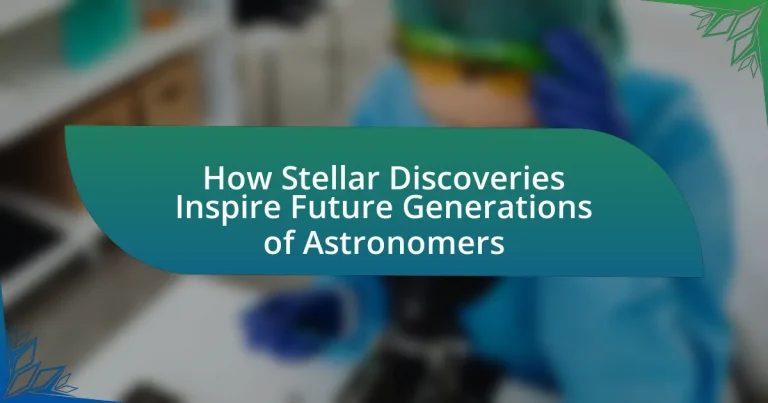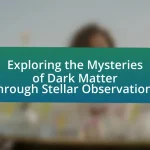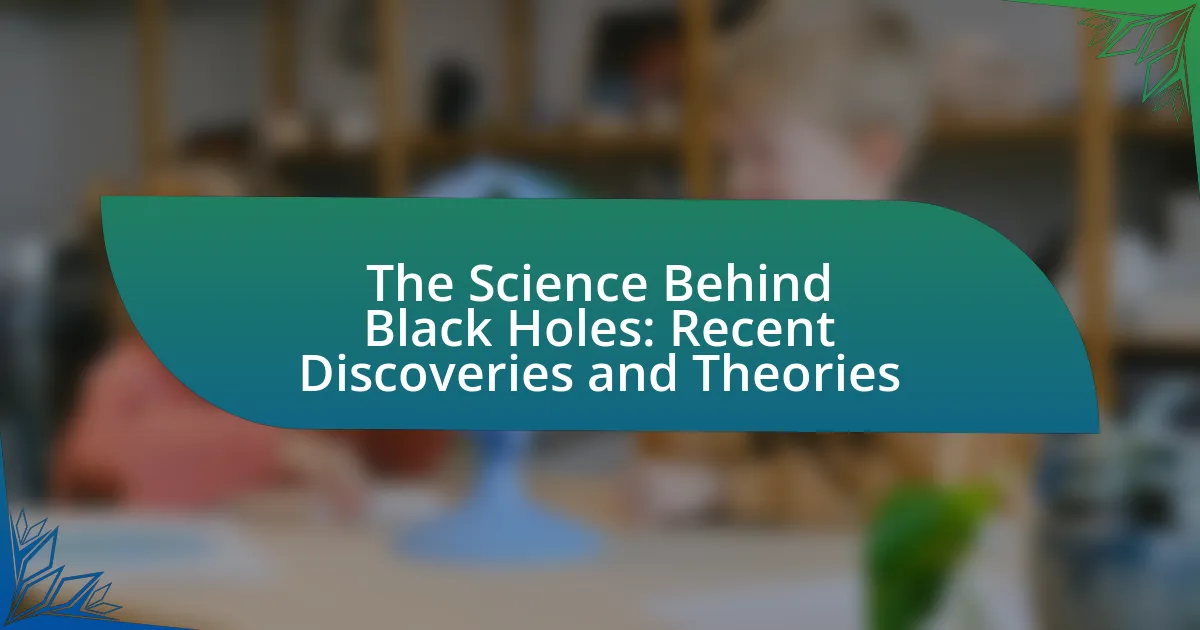The article focuses on how stellar discoveries shape the future of astronomy and inspire new generations of astronomers. It highlights significant historical discoveries, such as the heliocentric model and the detection of exoplanets, and discusses their impact on research priorities and technological advancements in the field. The article also examines the role of educational programs, collaborations, and mentorship in fostering interest in astronomy, as well as practical steps aspiring astronomers can take to engage with ongoing research. Additionally, it addresses the importance of staying updated on discoveries through various resources and the influence of social media and astronomy clubs in enhancing knowledge and community engagement.
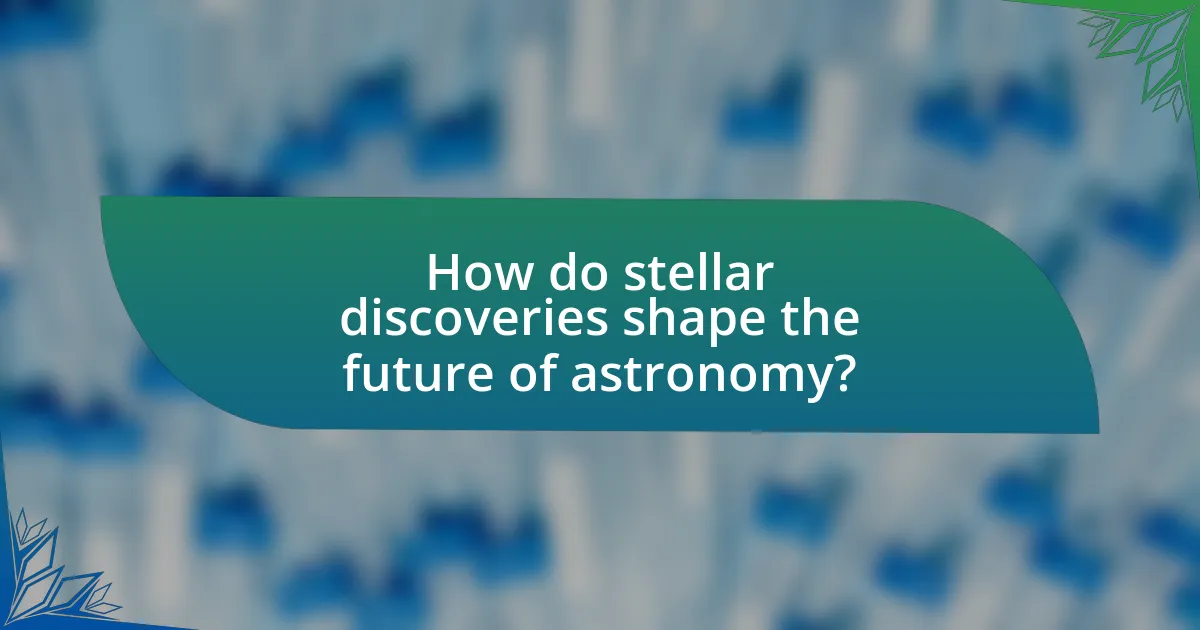
How do stellar discoveries shape the future of astronomy?
Stellar discoveries significantly shape the future of astronomy by expanding our understanding of the universe and guiding research priorities. For instance, the discovery of exoplanets has led to a surge in interest and funding for planetary science, influencing the development of new telescopes and observational techniques. Additionally, breakthroughs such as the detection of gravitational waves have opened new avenues for studying cosmic events, prompting astronomers to explore phenomena previously thought to be undetectable. These discoveries not only inspire current researchers but also attract new generations of astronomers, fostering innovation and collaboration in the field.
What are some significant stellar discoveries in history?
Some significant stellar discoveries in history include the identification of the heliocentric model by Nicolaus Copernicus, which revolutionized the understanding of our solar system by placing the Sun at its center rather than the Earth. Additionally, the discovery of the first exoplanet orbiting a sun-like star in 1995 by Michel Mayor and Didier Queloz expanded the search for life beyond Earth. The detection of cosmic microwave background radiation in 1965 by Arno Penzias and Robert Wilson provided strong evidence for the Big Bang theory, fundamentally altering the understanding of the universe’s origins. Each of these discoveries has had profound implications for astronomy and has inspired future generations of astronomers to explore the cosmos further.
How did the discovery of pulsars influence astronomical research?
The discovery of pulsars significantly advanced astronomical research by providing a new method for measuring cosmic distances and testing theories of gravity. Pulsars, which are highly magnetized rotating neutron stars emitting beams of electromagnetic radiation, serve as precise cosmic clocks due to their regular pulsation periods. This regularity allows astronomers to use pulsars for timing experiments, which have been instrumental in confirming aspects of general relativity, such as the existence of gravitational waves, as demonstrated by the Hulse-Taylor binary pulsar observations in 1974. Additionally, pulsars have facilitated the study of the interstellar medium and the structure of our galaxy, enhancing our understanding of stellar evolution and the dynamics of neutron stars.
What impact did the Hubble Space Telescope have on our understanding of the universe?
The Hubble Space Telescope significantly advanced our understanding of the universe by providing high-resolution images and data that revealed the existence of exoplanets, the rate of expansion of the universe, and the presence of dark energy. Its observations led to the discovery of the accelerating expansion of the universe, as evidenced by the work of astronomers like Adam Riess and Saul Perlmutter, who were awarded the Nobel Prize in Physics in 2011 for their contributions to this field. Hubble’s ability to observe distant galaxies and cosmic phenomena has transformed our knowledge of cosmic evolution and the lifecycle of stars, thereby inspiring future generations of astronomers to explore the universe further.
Why are stellar discoveries important for aspiring astronomers?
Stellar discoveries are crucial for aspiring astronomers because they provide foundational knowledge and inspiration for understanding the universe. These discoveries, such as the identification of exoplanets or the observation of supernovae, enhance the scientific framework within which new astronomers can develop their skills and theories. For instance, the discovery of over 5,000 exoplanets has expanded the field of astrobiology, encouraging young astronomers to explore the potential for life beyond Earth. Additionally, significant findings like the detection of gravitational waves have opened new avenues for research, demonstrating the dynamic nature of the cosmos and motivating future generations to engage in innovative scientific inquiry.
How do these discoveries ignite curiosity in young minds?
Stellar discoveries ignite curiosity in young minds by presenting awe-inspiring phenomena that challenge their understanding of the universe. For instance, the discovery of exoplanets has opened up discussions about the possibility of life beyond Earth, prompting children to ask questions about their own existence and the nature of life in the cosmos. Research indicates that exposure to such discoveries can enhance critical thinking and problem-solving skills in youth, as they engage with complex concepts like gravity, light years, and the vastness of space. This engagement fosters a sense of wonder and encourages exploration, leading to a deeper interest in science and astronomy.
What role do educational programs play in promoting interest in astronomy?
Educational programs play a crucial role in promoting interest in astronomy by providing structured learning experiences that engage students with the subject. These programs often include hands-on activities, interactive demonstrations, and access to telescopes, which enhance understanding and spark curiosity about celestial phenomena. Research indicates that students who participate in astronomy-related educational initiatives show increased enthusiasm for science, as evidenced by a study conducted by the National Science Foundation, which found that 75% of participants reported a greater interest in pursuing STEM careers after engaging in astronomy education.
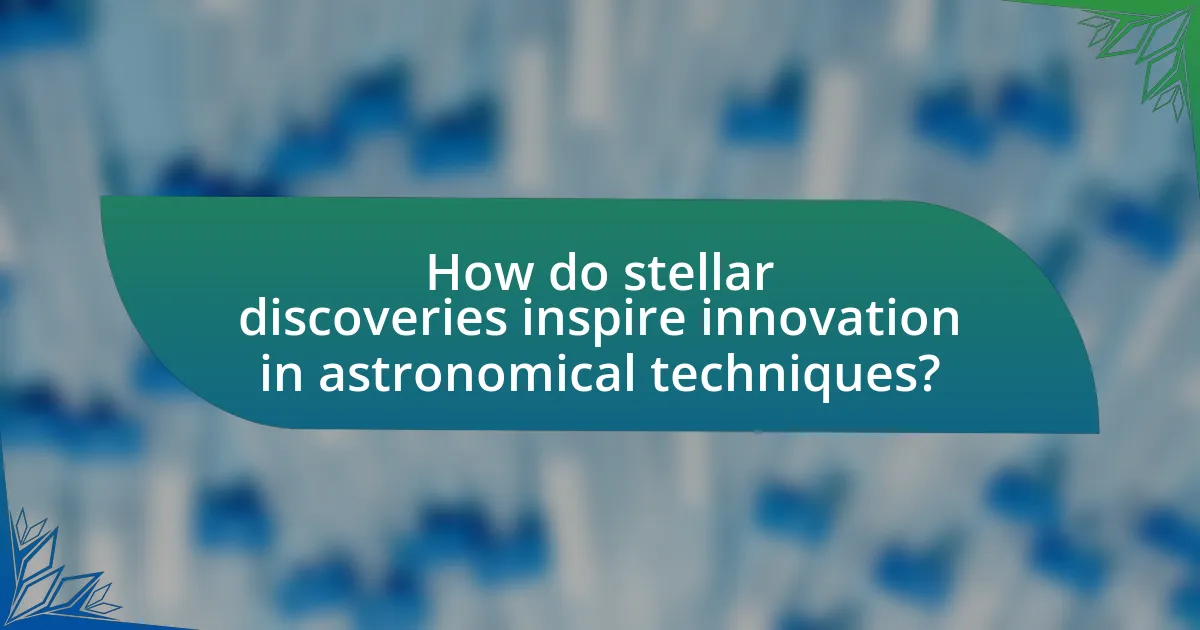
How do stellar discoveries inspire innovation in astronomical techniques?
Stellar discoveries inspire innovation in astronomical techniques by revealing new phenomena that require advanced observational methods and technologies. For instance, the discovery of exoplanets has led to the development of transit photometry and radial velocity techniques, which enhance our ability to detect and characterize distant worlds. Additionally, the observation of gravitational waves from merging black holes has spurred innovations in interferometry and data analysis, enabling more precise measurements of cosmic events. These advancements not only improve our understanding of the universe but also drive technological progress in fields such as optics, computing, and data science, demonstrating a direct link between stellar discoveries and the evolution of astronomical methodologies.
What new technologies have emerged from recent stellar discoveries?
Recent stellar discoveries have led to the emergence of advanced technologies such as gravitational wave detectors and next-generation telescopes. Gravitational wave detectors, like LIGO and Virgo, utilize laser interferometry to measure minute changes in distance caused by passing gravitational waves, enabling the observation of cosmic events like black hole mergers. Additionally, next-generation telescopes, including the James Webb Space Telescope, employ innovative infrared technology to capture detailed images of distant galaxies and stellar formations, enhancing our understanding of the universe’s evolution. These technologies are direct results of breakthroughs in astrophysics and engineering, demonstrating the practical applications of stellar research.
How has spectroscopy advanced due to discoveries in stellar astronomy?
Spectroscopy has advanced significantly due to discoveries in stellar astronomy by enabling precise measurements of stellar compositions and movements. The identification of spectral lines in starlight, first observed by Joseph von Fraunhofer in the early 19th century, allowed astronomers to determine the chemical elements present in stars. This foundational work was expanded upon by the discovery of the Doppler effect, which facilitated the measurement of stellar velocities through redshift and blueshift observations.
Furthermore, the development of high-resolution spectroscopy techniques, such as echelle spectroscopy, has allowed for the detailed analysis of stellar atmospheres, leading to insights into stellar evolution and the lifecycle of stars. The Hubble Space Telescope and other space-based observatories have provided unprecedented access to stellar spectra, enhancing our understanding of phenomena like supernovae and exoplanet atmospheres. These advancements have collectively transformed spectroscopy into a vital tool in modern astrophysics, allowing for the exploration of the universe’s fundamental properties.
What are the implications of adaptive optics in modern astronomy?
Adaptive optics significantly enhances image quality in modern astronomy by correcting distortions caused by Earth’s atmosphere. This technology allows telescopes to achieve near-diffraction-limited resolution, enabling astronomers to observe celestial objects with unprecedented clarity. For instance, the Keck Observatory in Hawaii utilizes adaptive optics to resolve details in distant galaxies and exoplanets, leading to discoveries that were previously unattainable. The implications of this advancement include improved understanding of star formation, galaxy evolution, and the potential for detecting habitable exoplanets, thereby inspiring future generations of astronomers to explore the universe more deeply.
How do collaborations in the astronomical community enhance discovery?
Collaborations in the astronomical community enhance discovery by pooling resources, expertise, and data, which leads to more comprehensive research outcomes. For instance, large-scale projects like the Sloan Digital Sky Survey involve thousands of astronomers worldwide, enabling the collection and analysis of vast amounts of data that no single institution could achieve alone. This collaborative approach has resulted in significant discoveries, such as the identification of millions of celestial objects and the mapping of the universe’s large-scale structure. Additionally, partnerships between observatories and research institutions facilitate the sharing of advanced technologies and methodologies, further accelerating the pace of discovery in astronomy.
What are some examples of successful international collaborations in astronomy?
Successful international collaborations in astronomy include the Hubble Space Telescope, which involves NASA and the European Space Agency, and the Event Horizon Telescope, a global collaboration that captured the first image of a black hole in 2019. The Hubble Space Telescope has provided invaluable data since its launch in 1990, enabling numerous discoveries about the universe, while the Event Horizon Telescope project combined data from radio observatories around the world, demonstrating the power of global scientific cooperation.
How do these collaborations inspire future generations of astronomers?
Collaborations in astronomy inspire future generations of astronomers by fostering innovation and providing access to diverse expertise and resources. These partnerships, such as those seen in large-scale projects like the Hubble Space Telescope and the Event Horizon Telescope, demonstrate the power of teamwork in overcoming complex challenges. For instance, the Hubble Space Telescope has led to significant discoveries, including the acceleration of the universe’s expansion, which has captivated young minds and encouraged them to pursue careers in astronomy. Furthermore, collaborative efforts often result in educational outreach programs that engage students, making the field more accessible and inspiring the next generation to explore the cosmos.

What practical steps can future astronomers take to engage with stellar discoveries?
Future astronomers can engage with stellar discoveries by actively participating in citizen science projects, utilizing online platforms to analyze astronomical data, and collaborating with professional astronomers. Citizen science initiatives, such as Galaxy Zoo, allow individuals to classify galaxies and contribute to ongoing research, fostering a hands-on approach to learning. Online platforms like NASA’s Exoplanet Exploration provide access to real-time data and educational resources, enabling aspiring astronomers to explore current discoveries. Additionally, collaboration with professional astronomers through internships or mentorship programs can provide invaluable experience and insight into the field, enhancing their understanding of stellar phenomena. These steps not only deepen knowledge but also inspire a lifelong passion for astronomy.
How can students get involved in astronomy research?
Students can get involved in astronomy research by participating in university-led projects, internships, and outreach programs. Many universities offer research opportunities where students can assist faculty members in ongoing projects, often leading to co-authorship on published papers. Additionally, internships at research institutions like NASA or observatories provide hands-on experience and exposure to professional research environments. Outreach programs, such as those organized by local planetariums or astronomy clubs, allow students to engage with the community while gaining practical skills. These avenues not only enhance students’ understanding of astronomy but also contribute to their academic and professional development in the field.
What resources are available for aspiring astronomers to learn more?
Aspiring astronomers can access a variety of resources to enhance their knowledge and skills. Key resources include online courses from platforms like Coursera and edX, which offer astronomy classes from reputable universities. Additionally, organizations such as the American Astronomical Society provide educational materials and networking opportunities. Books like “Cosmos” by Carl Sagan and “Astrophysics for People in a Hurry” by Neil deGrasse Tyson serve as excellent introductory texts. Furthermore, local observatories and planetariums often host workshops and public lectures, allowing hands-on experience and direct interaction with professionals in the field. These resources collectively support aspiring astronomers in their learning journey.
How can mentorship programs support young astronomers?
Mentorship programs can support young astronomers by providing guidance, networking opportunities, and access to resources that enhance their learning and career development. These programs connect inexperienced astronomers with established professionals who can share valuable insights and experiences, fostering skill development and confidence. Research indicates that mentorship significantly improves retention rates in STEM fields; for instance, a study published in the Journal of Science Education and Technology found that students with mentors are 55% more likely to pursue careers in their field. This structured support helps young astronomers navigate challenges, gain practical knowledge, and build professional relationships essential for their future success.
What are the best practices for staying updated on stellar discoveries?
To stay updated on stellar discoveries, regularly follow reputable scientific journals and astronomy news websites. Journals such as “The Astrophysical Journal” and “Astronomy & Astrophysics” publish peer-reviewed research on stellar phenomena, while websites like NASA, ESA, and Space.com provide timely updates on new findings. Subscribing to newsletters from these sources ensures direct access to the latest research and announcements. Additionally, participating in astronomy forums and attending conferences can facilitate engagement with the scientific community, enhancing awareness of ongoing discoveries. These practices are supported by the fact that peer-reviewed journals are the primary means of disseminating validated scientific knowledge, ensuring that the information is credible and up-to-date.
How can social media and online platforms facilitate learning in astronomy?
Social media and online platforms facilitate learning in astronomy by providing accessible resources, interactive communities, and real-time updates on astronomical events. These platforms, such as Twitter and YouTube, allow users to follow renowned astronomers and institutions, gaining insights into current research and discoveries. For instance, NASA’s social media accounts share live streams of events like solar eclipses and Mars rover landings, engaging millions and enhancing public interest in astronomy. Additionally, online forums and educational websites enable collaborative learning, where enthusiasts can discuss concepts, share findings, and participate in citizen science projects, such as Galaxy Zoo, which invites users to classify galaxies, contributing to real scientific research.
What role do astronomy clubs play in fostering interest and knowledge?
Astronomy clubs play a crucial role in fostering interest and knowledge by providing a community for enthusiasts to share experiences and learn collaboratively. These clubs often organize events such as star parties, lectures, and workshops, which enhance members’ understanding of astronomical concepts and observational techniques. For instance, the American Astronomical Society reports that participation in local astronomy clubs significantly increases members’ engagement with the subject, leading to a deeper appreciation for the universe. Additionally, clubs often facilitate access to telescopes and other equipment, allowing members to gain hands-on experience that reinforces theoretical knowledge.
